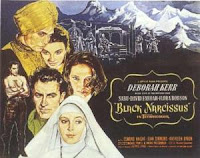 In watching this I was not anticipating much as I had seen Eddie Murphy's 1996 version of The Nutty Professor. I am not a fan of screwball comedies. Especially those of modern film where the humor is forced, exaggerated and primarily based on insults and crass humor. As I viewer, I require more substantial plots, humor and comedy. Jerry Lewis created a comical masterpiece with this film. I was disappointed when I read that Lewis produced the 1996 version and the 2000 sequel to that. That disappoint turned to relief when I further read that Lewis regretted his participation in those films. His disappointment and regret came from the crass humor Murphy used to get laughs.
In watching this I was not anticipating much as I had seen Eddie Murphy's 1996 version of The Nutty Professor. I am not a fan of screwball comedies. Especially those of modern film where the humor is forced, exaggerated and primarily based on insults and crass humor. As I viewer, I require more substantial plots, humor and comedy. Jerry Lewis created a comical masterpiece with this film. I was disappointed when I read that Lewis produced the 1996 version and the 2000 sequel to that. That disappoint turned to relief when I further read that Lewis regretted his participation in those films. His disappointment and regret came from the crass humor Murphy used to get laughs.This film is a fine example of how comedians could tactfully evoke humor without stooping to low gags and cheap one liners. This film brilliantly portrays Professor Julius Kelp (Lewis) failing in every way as a Professor. He blows up classrooms, has no respect from other administrators and is bullied by his students. The last straw is when a student throws him into a cabinet in front of the entire classroom and he is rescued by a beautiful student Stella Purdy (Stella Stevens). It's time for a change and he decides to take up going to the gym. Not getting the results he wants, he creates a serum to help him gain confidence. The results are far more then he could have imagined. Not only is he confident, but he is dashingly handsome, smooth talking and an instant social success. But there are side effects. His new alter ego, Buddy as he goes by, is cocky, arrogant and egotistical.
On his first night out as Buddy, he dazzles club goers with a stint at the piano crooning "That Old Black Magic." He gives a lesson in etiquette to a bartender and teaches him how to make a new drink. He keeps the boys in line and the women in awe, particularly Stella. With his smooth talking, he gets her to take him to a make out destination where he completely offends Stella with his arrogant, sexist attitude and expectations for her to provide some action. Being a complete sweet talker, he turns everything around and lays the romance on her. She is swooned and helplessly in love. As the connection between the two becomes strong, Buddy's voice begins to change. Instantly he goes from a smooth talker to the nerdy Professor. Before Stella can fully understand what his happening, Buddy disappears. Stella is left stunned, thinking only of Buddy. Upon seeing him in class as the nerdy professor, she does not connect, nor does anybody for that matter, that these two completely different men are really one in the same.
Eventually the dual roles catch up with him and he learns a valuable lesson about liking who you are. Stella reveals she always liked him or he was and order is restored as is romance.
What does conuse me about this movie, and maybe it was explained and I missed it, is where this takes place. It seems to be a University as the teachers are all professors and doctors. But then they have a senior prom implying it is high school. Which o course raises questions as to the teacher/student relationship. Other then this irritating act, the ilm is enjoyable. The transormation from geeky professor to swingin' ladies man is well done. Unlike it's 90's counterparts this film is fresh and the comedy is based on the plot rather then unneccessary crass jokes or one liners.
